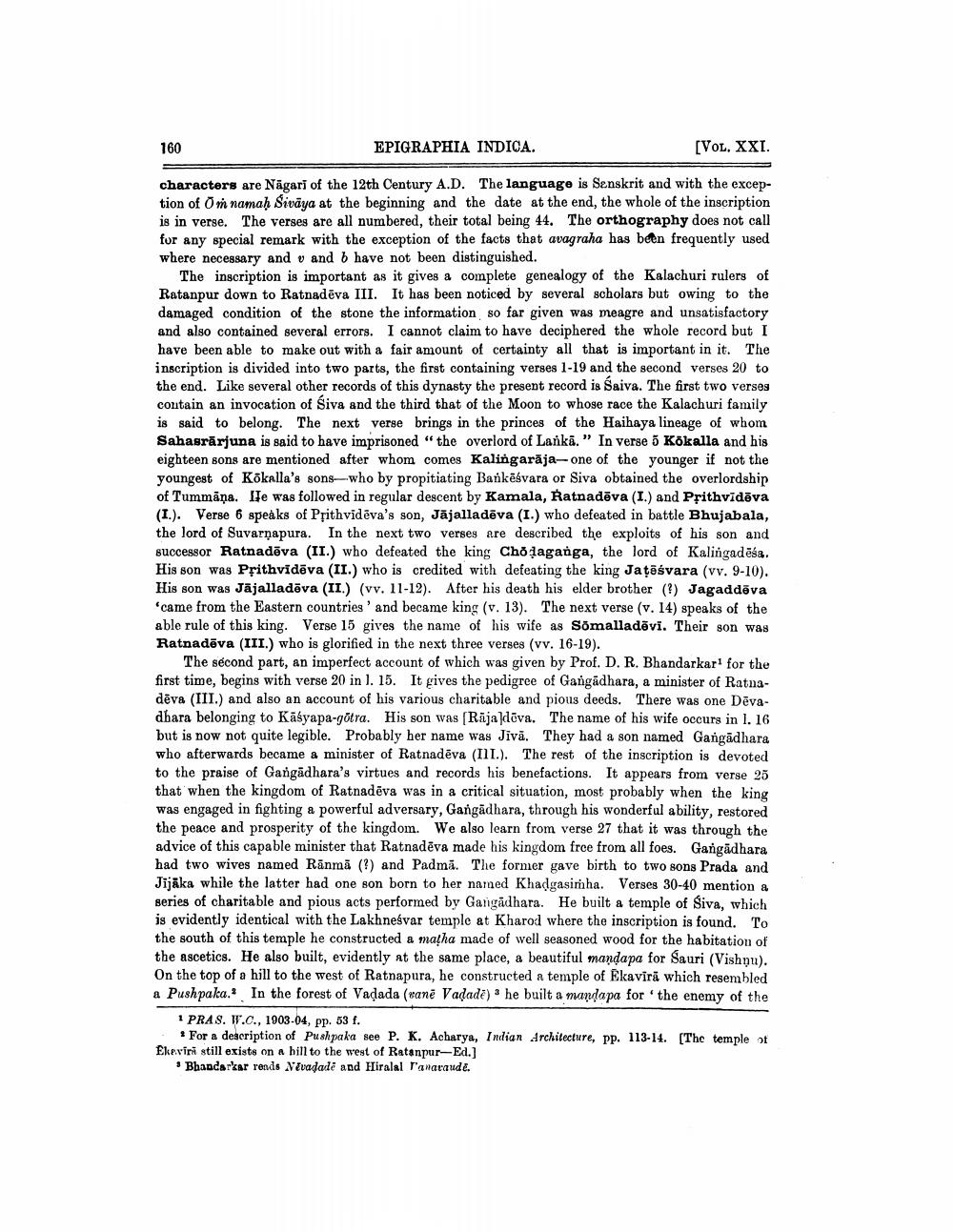________________
160
EPIGRAPHIA INDICA.
[VOL. XXI.
characters are Nāgari of the 12th Century A.D. The language is Sanskrit and with the exception of om namah Sivāya at the beginning and the date at the end, the whole of the inscription is in verse. The verses are all numbered, their total being 44. The orthography does not call for any special remark with the exception of the facts that avagraha has been frequently used where necessary and u and b have not been distinguished.
The inscription is important as it gives a complete genealogy of the Kalachuri rulers of Ratanpur down to Ratnadēva III. It has been noticed by several scholars but owing to the damaged condition of the stone the information so far given was meagre and unsatisfactory and also contained several errors. I cannot claim to have deciphered the whole record but I have been able to make out with a fair amount of certainty all that is important in it. The inscription is divided into two parts, the first containing verses 1-19 and the second verses 20 to the end. Like several other records of this dynasty the present record is Saiva. The first two verses coutain an invocation of Siva and the third that of the Moon to whose race the Kalachuri family is said to belong. The next verse brings in the princes of the Haihaya lineage of whom Sahagrārjuna is said to have imprisoned "the overlord of Lankā." In verse 5 Kökalla and his eighteen sons are mentioned after whom comes Kalingarāja-one of the younger if not the youngest of Kökalla's sons-who by propitiating Bankēsvara or Siva obtained the overlordship of Tummāņa. IJe was followed in regular descent by Kamala, Ratnadēva (I.) and Prithvidēva (I.). Verse 6 speaks of Přithvidēva's son, Jājalladēva (I.) who defeated in battle Bhujabala, the lord of Suvarnapura. In the next two verses are described the exploits of his son and successor Ratnadēva (II.) who defeated the king Cholaganga, the lord of Kalingadēša. His son was Pfithvidēva (II.) who is credited with defeating the king Jaţēśvara (vv. 9-10). His son was Jājalladēva (II) (vv. 11-12). After his death his elder brother (?) Jagaddēva
came from the Eastern countries' and became king (v. 13). The next verse (v. 14) speaks of the able rule of this king. Verse 15 gives the name of his wife as Somalladēvi. Their son was Ratnadēva (III.) who is glorified in the next three verses (vv. 16-19).
The second part, an imperfect account of which was given by Prof. D. R. Bhandarkar for the first time, begins with verse 20 in l. 15. It gives the pedigree of Gangadhara, a minister of Ratnadēva (III.) and also an account of his various charitable and pious deeds. There was one Dēvadbara belonging to Kāsyapa-gotra. His son was (Rājaldova. The name of his wife occurs in l. 16 but is now not quite legible. Probably her name was Jivā. They had a son named Gangādhara who afterwards became a minister of Ratnadēva (III.). The rest of the inscription is devoted to the praise of Gangādhara's virtues and records his benefactions. It appears from verse 25 that when the kingdom of Ratnadēva was in a critical situation, most probably when the king was engaged in fighting a powerful adversary, Gangadhara, through his wonderful ability, restored the peace and prosperity of the kingdom. We also learn from verse 27 that it was through the advice of this capable minister that Ratnadēva made his kingdom free from all foes. Gangadhara had two wives named Rānmã (?) and Padmā. The former gave birth to two sons Prada and Jijāka while the latter had one son born to her named Khadgasimha. Verses 30-40 mention a series of charitable and pious acts performed by Gangadhara. He built a temple of Siva, which is evidently identical with the Lakhneśvar temple at Kharod where the inscription is found. To the south of this temple he constructed a matha made of well seasoned wood for the habitation of the ascetics. He also built, evidently at the same place, a beautiful mandapa for Sauri (Vishnu). On the top of a hill to the west of Ratnapura, he constructed a temple of Ekavirā which resembled a Pushpaka. In the forest of Vadada (vanē Vadade)' he built a mandapa for the enemy of the
1 PRAS. W.C., 1903-04, pp. 53 f.
For a description of Pushpaka see P. K. Acharya, Indian Architecture, pp. 113-14. [The temple of Ekeviri still existe on a hill to the west of Ratanpur-Ed.]
Bhandarkar rends Nevadade and Hiralal r'anaraude.




